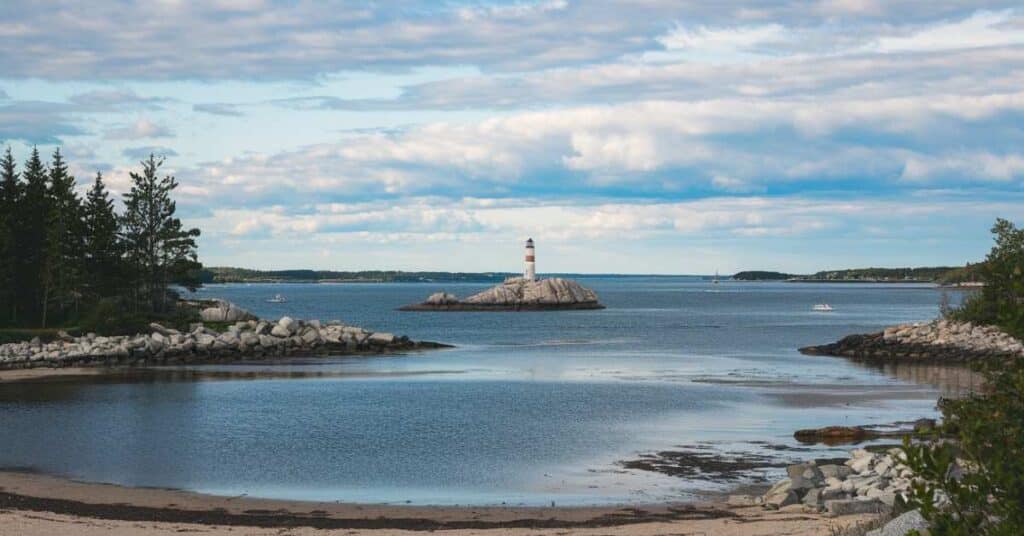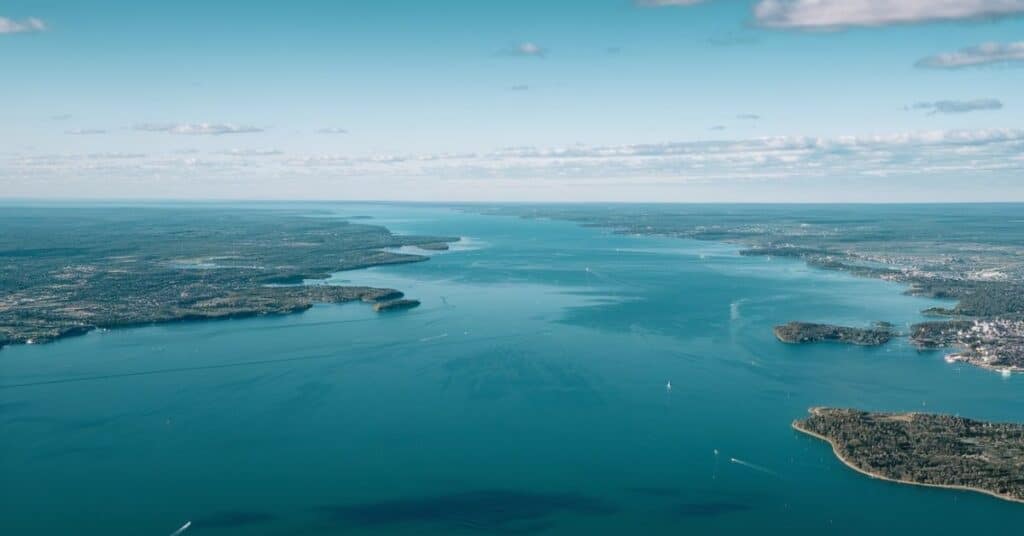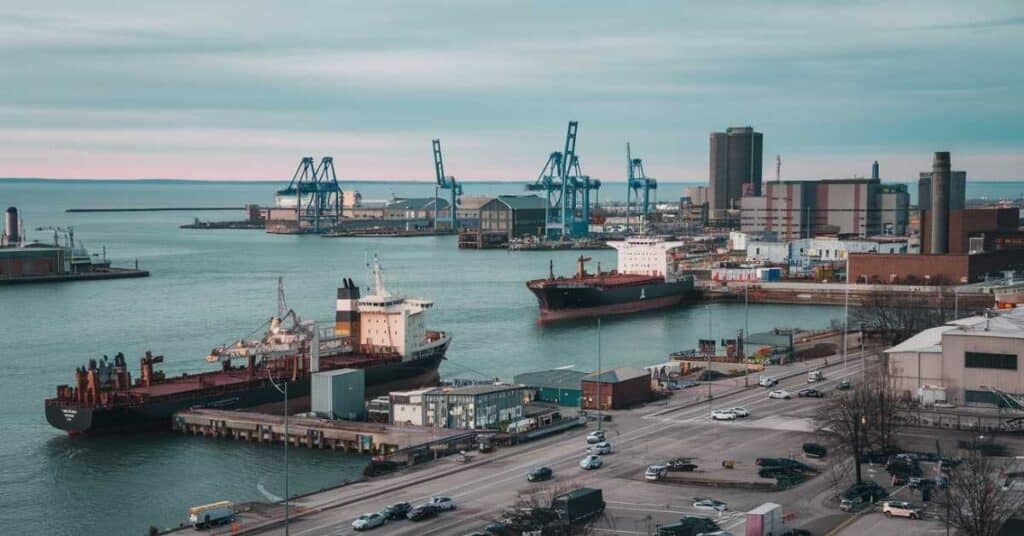Lake Michigan, one of the largest and most beautiful of the Great Lakes, holds a prominent place in North America’s geography. Spanning over 22,400 square miles, it is a vital resource for millions of people who rely on it for drinking water, recreation, and trade. But how does it compare in size, depth, and volume to other major lakes around the world?
In this post, we will explore Michigan’s full scope, covering its surface area, depth, islands, shoreline, seasonal water level changes, and its connection to neighboring Great Lakes. We’ll also examine its scale and influence compared to other significant lakes globally.
Size and Surface Area of Lake Michigan
Michigan spans an impressive 22,400 square miles, making it the second largest of the Great Lakes by surface area and the fifth largest freshwater in the world. Below is a breakdown of the lake’s surface area, length, width, and shoreline.
| Feature | Measurement |
| Surface Area | 22,400 square miles (58,000 km²) |
| Length | 307 miles (494 km) |
| Width | 118 miles (190 km) at its widest point |
| Shoreline Length | 1,640 miles (2,639 km) |
The lake stretches across four U.S. states, Michigan, Illinois, Indiana, and Wisconsin touching cities like Chicago, Milwaukee, and Grand Rapids. It could even fit an entire country like Israel inside its borders.
Lake Michigan’s Dimensions Compared to Other Major Lakes
Michigan is impressive in its own right, but it is helpful to compare its dimensions with other famous in worldwide. This comparison provides context for the sheer scale of Lake Michigan and highlights the remarkable characteristics of other global lakes.
Lake Michigan vs. Other Great Lakes
Michigan is part of the Great Lakes, which includes Superior, Huron, Erie, and Ontario. Here’s how Michigan compares to others in the region:
| Lake Name | Surface Area (sq mi) | Length (miles) | Maximum Depth (ft) | Volume (cubic miles) |
| Michigan | 22,400 | 307 | 923 | 4,918 |
| Superior | 31,700 | 350 | 1,332 | 2,900 |
| Huron | 23,000 | 206 | 750 | 3,540 |
| Erie | 9,910 | 241 | 210 | 480 |
| Ontario | 7,340 | 193 | 802 | 393 |
Read More “Length Measurements and the Metric System”
Key Differences:
- Superior is the largest and deepest of the Great Lakes, surpassing Michigan in both surface area and depth.
- Huron is almost as large as Michigan in surface area but has a smaller maximum depth.
- Erie and Ontario are smaller, with significantly lower volumes and shallower depths than Michigan.
Comparison with Global Lakes
Now let us compare Lake Michigan with some of the largest lakes in the world. While Lake Michigan is an immense body of water, it is not the largest in the world. However, it is still remarkably large when compared to other fresh water lakes globally.
| Lake Name | Surface Area (sq mi) | Country or Region | Maximum Depth (ft) | Volume (cubic miles) |
| Michigan | 22,400 | United States | 923 | 4,918 |
| Baikal | 12,248 | Russia | 5,387 | 23,600 |
| Tanganyika | 12,700 | Tanzania, DRC, Burundi, Zambia | 4,823 | 4,500 |
| Victoria | 26,828 | Uganda, Kenya, Tanzania | 83 | 2,424 |
| Ontario | 7,340 | United States/Canada | 802 | 393 |
Key Global Comparisons:
- Baikal in Russia is the largest freshwater body by volume and depth, vastly exceeding Michigan’s depth and volume.
- Tanganyika is almost the same size in surface area as Michigan, but its maximum depth is much greater.
- Victoria, the largest in Africa, is larger in surface area than Michigan but has a much lower depth.
Depth and Volume of Lake Michigan
The size of Michigan is not just about its surface area—its depth and volume are also remarkable. Below is a detailed look at the lake’s depth, maximum depth, and total volume.
| Feature | Measurement |
| Maximum Depth | 923 feet (281 meters) |
| Average Depth | 279 feet (85 meters) |
| Volume | 4,918 cubic miles (20,000 km³) |
To put this in perspective, Lake Michigan holds more than 4,918 cubic miles of water, which is enough to fill 1.6 trillion Olympic sized swimming pools. This immense volume of water is crucial for the water supply of the surrounding regions and the transportation of goods via shipping routes.
Read More “New York Cricket Stadium: Guide to Dimensions and Features”
water quality of Lake Michigan
Michigan’s water quality has improved over the years, but it still faces threats like pollution and invasive species. While regulations have reduced industrial runoff, agricultural pollution and urban wastewater continue to pose challenges. Ongoing efforts are needed to maintain and improve the water quality.
Pollution Sources Affecting Water Quality
Pollution from stormwater runoff, agricultural chemicals, and industrial waste remains a significant concern for Lake Michigan. These pollutants contribute to harmful algae blooms and degrade the water quality, impacting both aquatic life and human use.
Impact of Invasive Species on Water Quality
Invasive species like zebra mussels and Asian carp disrupt the ecosystem and impact water quality by altering the food chain. Zebra mussels, in particular, filter water but reduce food sources for native species, exacerbating the challenges Lake Michigan faces.
Shoreline Features and Coastal Areas

The shoreline of Lake Michigan is diverse, featuring sandy beaches, towering cliffs, and urban waterfronts. Below are some notable features along the lake’s coast:
| Coastal Feature | Location |
| Indiana Dunes National Park | Indiana |
| Sleeping Bear Dunes National Lakeshore | Michigan |
| Grand Haven Bluff | Michigan |
| Lakefront Trail (Chicago) | Illinois |
| Mackinac Island | Michigan |
Types of Shoreline
Lake Michigan’s shoreline includes a mix of natural beauty and human development:
- Beaches: Locations like Indiana Dunes and Sleeping Bear Dunes offer natural beaches ideal for visitors.
- Cliffs and Bluffs: Coastal areas like Grand Haven Bluff provide stunning views of the lake from elevated points.
- Urban Waterfronts: Major cities such as Chicago and Milwaukee feature developed shorelines with parks, beaches, and trails.
Islands of Lake Michigan

Lake Michigan is home to several islands, each with its own unique characteristics. These islands vary in size and importance, with some serving as tourist destinations, while others have historical or ecological significance.
| Island Name | Key Features |
| Beaver Island | The largest island on Michigan, home to scenic views and historic sites |
| Mackinac Island | Famous for its historic architecture, car free environment, and tourism |
| Washington Island | Known for its agriculture and rural community in Door County, Wisconsin |
| North Manitou Island | Popular for hiking, camping, and natural preservation |
These islands add another layer of complexity to Lake Michigan’s ecosystem and provide stunning, untouched natural spaces for outdoor activities.
Read More “Clothing Measurements: How to Measure Your Size for Clothing”
Eco Friendly Tourism at Lake Michigan

Lake attracts millions of visitors annually, but sustainable tourism is key to preserving its beauty. Local efforts focus on reducing environmental impact through clean energy, waste reduction, and eco friendly transportation options.
Sustainable Practices Along the Shoreline
Several beaches and parks around Lake Michigan have adopted eco friendly practices, such as using solar energy for lighting and promoting reusable materials. These initiatives help keep the lake’s ecosystem thriving.
Green Tourism in Lake Michigan’s Cities

Cities like Chicago and Milwaukee offer sustainable tourism options, such as eco tours and green hotels, which focus on reducing their environmental footprint while still offering incredible experiences for visitors.
Environmental Impact of Lake Michigan
The size and water volume of Lake make it a critical ecological resource, supporting diverse wildlife and plant life. However, its ecosystem faces challenges from pollution, invasive species, and climate change.
Biodiversity of Lake Michigan
This area is home to a variety of species, including fish such as trout and walleye, as well as migratory birds that use its shores for nesting. Its expansive size provides ample space for a wide range of organisms to thrive.
| Species | Role in Ecosystem |
| Lake Trout | Predatory fish, important for fishing industry |
| Walleye | Popular game fish, supports local recreation |
| Migratory Birds | Utilize the lake for nesting and rest during migration |
Challenges Facing the Lake’s Ecosystem
- Invasive Species: Species like zebra mussels and Asian carp threaten local biodiversity.
- Pollution: Runoff from agriculture and urban areas contributes to water contamination.
- Climate Change: Rising temperatures affect water levels and species migration patterns.
Efforts by government agencies and environmental organizations continue to combat these issues through conservation programs and initiatives aimed at improving water quality.
Read Further Our Article “How Big is Chicago? Explore the City’s Dimensions and Charm”
Economic Impact of Lake Michigan

It is not just a beautiful natural feature; it also plays a vital role in the local economies of the surrounding states. From shipping and industry to tourism and recreation, the lake is central to regional development.
Fun Fact: Over 10 million tourists visit Lake Michigan each year to enjoy its stunning beaches, parks, and recreational activities.
| Industry | Economic Contribution |
| Shipping | Essential for transporting goods such as iron ore, grain, and coal |
| Tourism | Generates billions of dollars annually, especially for cities like Chicago, Milwaukee, and Grand Rapids |
| Fishing | Provides jobs and recreation for thousands, with a rich history in the commercial fishing industry |
Major Ports
- Chicago Harbor: One of the busiest ports on the Great Lakes, playing a critical role in global trade.
- Milwaukee Port: Significant for transporting goods throughout the region.
Read Further About “What Are the Typical Dimensions of a Flower Bouquet?”
FAQs
What is the depth of Lake Michigan?
The maximum depth is 923 feet (281 meters), with an average depth of 279 feet (85 meters).
How does Lake Michigan compare to other Great Lakes?
Michigan is the second largest of the Great Lakes by surface area, after Superior. It is also the largest body of water in the world entirely within one country.
What is the size of Lake Michigan?
It has a surface area of 22,400 square miles (58,000 km²), making it the fifth largest freshwater lake in the world.
Conclusion: The Magnificent Dimensions of Lake Michigan
Lake Michigan’s massive size, depth, and ecological diversity make it one of the most important bodies of freshwater in the United States. From its 22,400 square miles of surface area to its 923 feet of depth, it stands as a monumental feature of the Midwest.
Whether comparing it to other Great Lakes or major lakes worldwide, Lake Michigan’s dimensions consistently place it among the largest and most influential freshwater lakes globally.
Read Further “How Big is New York City? Dimensions and Population Over Time”

My name is Linda, and I am an experienced blogger with a passion for precision and craftsmanship. With years of expertise, I contribute to Accura Matrics, bringing a wealth of knowledge and a keen eye for detail. My insightful articles and expert tips are designed to help readers achieve excellence in their measurements and dimensions projects, offering valuable guidance in the pursuit of accurate and thoughtful design.

